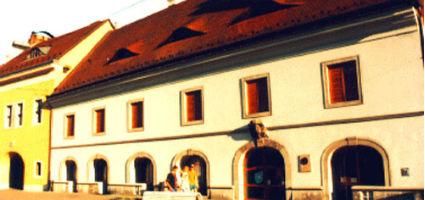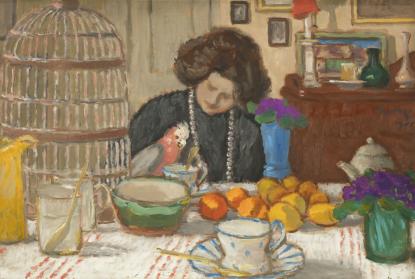2024. April 19. Friday
Gallery of Miskolc Museum of Contemporary Art - Miskolc
 |
Address: 3530, Miskolc Rákóczi utca 2.
Phone number: (46) 500-680, (46) 500-681
E-mail: miskolcigaleria@gmail.com
Opening hours: 07.09-31.05.: Tue-Sat 9-17
01.06-06.09.: Tue-Sun 10-18 13.06-24.06.: Tue-Sun 10-23 |
The exhibition has closed for visitors.
2015.12.22. - 2016.08.31.
Museum tickets, service costs:
|
Ticket for adults
|
310 HUF
|
|
|
Ticket for students
|
160 HUF
|
|
|
Ticket for pensioners
|
160 HUF
|
The sensational news broke this summer that the art collection known as the secret collection of István Kövesi, a butcher of Újlipótváros was purchased by the Hungarian National Bank under the Depository Program for 795 million forints, and locate it as a deposit at the Herman Otto Museum. The collection has recently arrived in Miskolc. The museum - in agreement with the leadership of the city - decided to present the collection of public domain to the public before Christmas.

For decades rumour had it among experts that somewhere in the capital there is a private collection consisting of unparalleled artistic treasure hidden of which one an outstanding piece from time to time was shown at prestigious exhibitions, but the full identity of which and at the same time the name of the owner until recently remained a secret.The closed nature of the collection, the secrecy surrounding the name of the collector can be explained by his personal experience gained during the historical times. István Kövesi was born in 1911-in Vácrátót into a Jewish family and lived through all the horrors that met his fellow believers.
Forced labour, stages of confiscation of property and deprivation of rights were followed by the horrors of concentration camps. He was the only member of his family who managed to return from Mauthausen, though skinny as a skeleton, suffering in typhoid. István Kövesi did not surrender, he married and continuing the family tradition opened a butchery not far from his birthplace, in Vác. With nationalization he lost his wealth again. He moved to Budapest where he worked as a factory labourer for years. In 1957 fortune smiled at him and took a fellow defector kosher meat shop management over in Újlipótváros. From then on, this business provided livelihood for the Kövesi family. The diligent work generated profit from the 60s onwards enabled the creation of art collection.István Kövesi learned for life that only those things can be preserved that are kept in secret. In the spirit of this experience, he kept his and enriched his collection locked away from the outside world.
The art collection that began initially as investment became a real passion for him. The butcher who only finished six years of elementary school, based on the advice of experts, constantly expanded his knowledge and became a connoisseur himself. He purchased part of the items in his collection at auction of the Consignment Store Company, or exchanged them with other art collectors or art historians. István Kövesi's art collection embraces almost one hundred years of Hungarian painting history. The item dating earliest is from the 1870s the one dating latest is from 1976, five years before Kövesi died. The collection purchased by the Hungarian National Bank consists of 115 items, which is the result of a subjective activity.
Several artists are represented in the collection, but artists such as Vilmos Aba-Novák, Margit Anna, Imre Ámos, Endre Bálint, Róbert Berény, Sándor Bortnyik, Béla Czóbel, József Egry, Lajos Kassák, László Mednyánszky, Izsák Perlmutter, József Rippl-Rónai, Hugó Scheiber, István Szőnyi, János Vaszary – are given special attention.Obtaining the Kövesi collection is of extreme importance for the Herman Ottó Museum, just as for the city of Miskolc. The common treasure that once was a secret collection will be temporary held in a warehouse after the exhibition period, but only until the new expanded exhibition hall in Görgey Street opens financed by the Regional Operational Programme where the collection will find its permanent home. Upon completion of construction works, on the first floor of the former party headquarters of the socialist era two major private collections, that of the doctor-collector Sándor Petró and artisan-collector István Kövesi will provide an outline of Hungarian art in the period between 1700 and 1970. The newly re-arranged Gallery is to select from two major private collections and the museum's core collection can be of Hungary's richest fine art attractions in terms of show area and historic overlap.The secret collection were formerly shown by the Kieselbach Gallery of Budapest in 2013, then the Rómer Flóris Art and History Museum of Győr. Both the media and the public showed unusual interest in the exhibitions.

For decades rumour had it among experts that somewhere in the capital there is a private collection consisting of unparalleled artistic treasure hidden of which one an outstanding piece from time to time was shown at prestigious exhibitions, but the full identity of which and at the same time the name of the owner until recently remained a secret.The closed nature of the collection, the secrecy surrounding the name of the collector can be explained by his personal experience gained during the historical times. István Kövesi was born in 1911-in Vácrátót into a Jewish family and lived through all the horrors that met his fellow believers.
Forced labour, stages of confiscation of property and deprivation of rights were followed by the horrors of concentration camps. He was the only member of his family who managed to return from Mauthausen, though skinny as a skeleton, suffering in typhoid. István Kövesi did not surrender, he married and continuing the family tradition opened a butchery not far from his birthplace, in Vác. With nationalization he lost his wealth again. He moved to Budapest where he worked as a factory labourer for years. In 1957 fortune smiled at him and took a fellow defector kosher meat shop management over in Újlipótváros. From then on, this business provided livelihood for the Kövesi family. The diligent work generated profit from the 60s onwards enabled the creation of art collection.István Kövesi learned for life that only those things can be preserved that are kept in secret. In the spirit of this experience, he kept his and enriched his collection locked away from the outside world.
The art collection that began initially as investment became a real passion for him. The butcher who only finished six years of elementary school, based on the advice of experts, constantly expanded his knowledge and became a connoisseur himself. He purchased part of the items in his collection at auction of the Consignment Store Company, or exchanged them with other art collectors or art historians. István Kövesi's art collection embraces almost one hundred years of Hungarian painting history. The item dating earliest is from the 1870s the one dating latest is from 1976, five years before Kövesi died. The collection purchased by the Hungarian National Bank consists of 115 items, which is the result of a subjective activity.
Several artists are represented in the collection, but artists such as Vilmos Aba-Novák, Margit Anna, Imre Ámos, Endre Bálint, Róbert Berény, Sándor Bortnyik, Béla Czóbel, József Egry, Lajos Kassák, László Mednyánszky, Izsák Perlmutter, József Rippl-Rónai, Hugó Scheiber, István Szőnyi, János Vaszary – are given special attention.Obtaining the Kövesi collection is of extreme importance for the Herman Ottó Museum, just as for the city of Miskolc. The common treasure that once was a secret collection will be temporary held in a warehouse after the exhibition period, but only until the new expanded exhibition hall in Görgey Street opens financed by the Regional Operational Programme where the collection will find its permanent home. Upon completion of construction works, on the first floor of the former party headquarters of the socialist era two major private collections, that of the doctor-collector Sándor Petró and artisan-collector István Kövesi will provide an outline of Hungarian art in the period between 1700 and 1970. The newly re-arranged Gallery is to select from two major private collections and the museum's core collection can be of Hungary's richest fine art attractions in terms of show area and historic overlap.The secret collection were formerly shown by the Kieselbach Gallery of Budapest in 2013, then the Rómer Flóris Art and History Museum of Győr. Both the media and the public showed unusual interest in the exhibitions.
